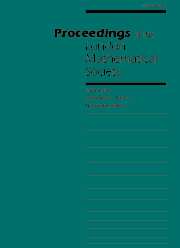Crossref Citations
This article has been cited by the following publications. This list is generated based on data provided by
Crossref.
Guerrero, Julio Becerra
Pérez, Ginés López
Peralta, Antonio M.
and
Rodríguez-Palacios, A
2004.
Relatively weakly open sets in closed balls of Banach spaces, and real JB*-triples of finite rank.
Mathematische Annalen,
Vol. 330,
Issue. 1,
p.
45.
Peralta, Antonio M.
2006.
Some remarks on weak compactness in the dual space of a JB*-triple.
Tohoku Mathematical Journal,
Vol. 58,
Issue. 2,
Burgos, María
Fernández-Polo, Francisco J.
Garcés, Jorge J.
Moreno, Juan Martínez
and
Peralta, Antonio M.
2008.
Orthogonality preservers in C∗-algebras, JB∗-algebras and JB∗-triples.
Journal of Mathematical Analysis and Applications,
Vol. 348,
Issue. 1,
p.
220.
Altwaijry, Najla A.
and
Edwards, C. Martin
2008.
The Banach–Lie algebra of multiplication operators on a JBW∗-triple.
Journal of Functional Analysis,
Vol. 254,
Issue. 11,
p.
2866.
Fernández-Polo, Francisco J.
and
Peralta, Antonio M.
2010.
On the facial structure of the unit ball in the dual space of a JB*-triple.
Mathematische Annalen,
Vol. 348,
Issue. 4,
p.
1019.
Fernández-Polo, Francisco J.
and
Peralta, Antonio M.
2010.
Non-commutative generalisations of Urysohn's lemma and hereditary inner ideals.
Journal of Functional Analysis,
Vol. 259,
Issue. 2,
p.
343.
Edwards, C. Martin
Fernández-Polo, Francisco J.
Hoskin, Christopher S.
and
Peralta, Antonio M.
2010.
On the facial structure of the unit ball in a JB*-triple.
Journal für die reine und angewandte Mathematik (Crelles Journal),
Vol. 2010,
Issue. 641,
Diestel, Joe
Peralta, Antonio M.
and
Puglisi, Daniele
2011.
Sequential w‐right continuity and summing operators.
Mathematische Nachrichten,
Vol. 284,
Issue. 5-6,
p.
664.
Burgos, Maria
Fernández-Polo, Francisco J.
and
Peralta, Antonio M.
2014.
Local triple derivations on C∗-algebras and JB∗-triples.
Bulletin of the London Mathematical Society,
Vol. 46,
Issue. 4,
p.
709.
Fernández-Polo, Francisco J.
Peralta, Antonio M.
and
Ramírez, María Isabel
2015.
A Kadec-Pelczyński dichotomy-type theorem for preduals of JBW*-algebras.
Israel Journal of Mathematics,
Vol. 208,
Issue. 1,
p.
45.
Isidro, José M.
2015.
On admissible topologies in JB*-triples.
Mathematische Nachrichten,
Vol. 288,
Issue. 11-12,
p.
1317.
Niazi, Mohsen
and
Peralta, Antonio M.
2015.
Weak-2-local ⁎-derivations on B(H) are linear ⁎-derivations.
Linear Algebra and its Applications,
Vol. 487,
Issue. ,
p.
276.
Peralta, Antonio M.
and
Pfitzner, Hermann
2016.
Perturbation of ℓ1-copies in preduals of JBW⁎-triples.
Journal of Mathematical Analysis and Applications,
Vol. 434,
Issue. 1,
p.
149.
Khosravi, Amin A.
Ebrahimi Vishki, Hamid Reza
and
Peralta, Antonio M.
2019.
Aron–Berner extensions of triple maps with application to the bidual of Jordan Banach triple systems.
Linear Algebra and its Applications,
Vol. 580,
Issue. ,
p.
436.
Abulhamil, Doha Adel
Jamjoom, Fatmah B.
and
Peralta, Antonio M.
2020.
Linear Maps Which are Anti-derivable at Zero.
Bulletin of the Malaysian Mathematical Sciences Society,
Vol. 43,
Issue. 6,
p.
4315.
Hamhalter, Jan
Kalenda, Ondřej F.K.
Peralta, Antonio M.
and
Pfitzner, Hermann
2020.
Measures of weak non-compactness in preduals of von Neumann algebras and JBW⁎-triples.
Journal of Functional Analysis,
Vol. 278,
Issue. 1,
p.
108300.
Fernández-Polo, Francisco J.
2020.
The minimax principle and related topics in the Jordan setting.
Linear Algebra and its Applications,
Vol. 604,
Issue. ,
p.
293.
Becerra-Guerrero, Julio
Cueto-Avellaneda, María
Fernández-Polo, Francisco J.
and
Peralta, Antonio M.
2021.
ON THE EXTENSION OF ISOMETRIES BETWEEN THE UNIT SPHERES OF A -TRIPLE AND A BANACH SPACE.
Journal of the Institute of Mathematics of Jussieu,
Vol. 20,
Issue. 1,
p.
277.
Garcés, Jorge J.
and
Peralta, Antonio M.
2021.
One-parameter semigroups of orthogonality preservers of JB*-algebras.
Advances in Operator Theory,
Vol. 6,
Issue. 2,
Garcés, Jorge J.
Li, Lei
Peralta, Antonio M.
and
Tahlawi, Haifa M.
2022.
A projection–less approach to Rickart Jordan structures.
Journal of Algebra,
Vol. 609,
Issue. ,
p.
567.

